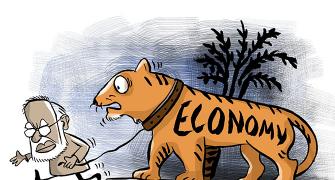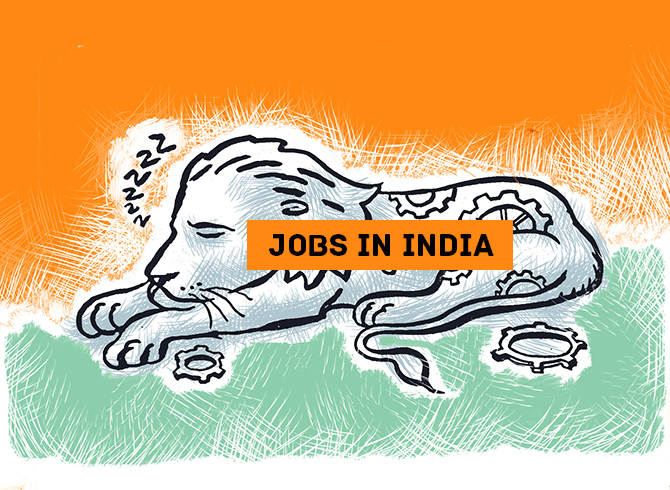The 7 per cent GDP growth estimates presented now by the official agencies do not resonate because employment is growing by only around 2 per cent per annum. And, real wages are growing by less than 4.5 per cent per annum in the relatively larger companies, says Mahesh Vyas.

Growth in employment by companies slowed down a tad in 2017-18 to 2.2 per cent compared to the modest 2.6 per cent growth recorded in 2016-17.
Nevertheless, the growth in these two years is better than it was in the preceding two years -- 2014-15 and 2015-16 when employment by companies had initially contracted by 2.7 per cent and then crawled up by a meagre 0.5 per cent.
While employment growth decelerated from 2.6 per cent in 2016-17 to 2.2 per cent in 2017-18, growth in wages inched up a bit from 9.4 per cent in 2016-17 to 9.5 per cent in 2017-18. As a result, growth in wages per employee accelerated from 6.6 per cent in 2016-17 to 7.1 per cent in 2017-18.
Real growth in wages (adjusted for consumer prices) accelerated from 5.1 per cent to 6.2 per cent and, real wages per employee shot up from 2.4 per cent to 3.9 per cent.
So, while employment growth slowed down in 2017-18, wages and also real wages per capita did improve in the year compared to 2016-17.
Underlying the 2.2 per cent growth in employment in 2017-18 lies much turmoil. Less than half -- only 46 per cent of the companies actually registered an increase in employment. 41 per cent of the companies registered a fall in employment and another 13 per cent did not record any change.
This is not unusual. In the past ten years, on an average only 48 per cent of the companies saw an increase in employment; 43 per cent saw a decline and the remaining recorded no change.
The golden period of employment growth and real wage growth per capita in the corporate sector was the six-year period 2003-04 through 2008-09.
During this period, employment grew on an average, at 3.5 per cent per annum and real wages grew at 10.7 per cent per annum. Per capita real wages grew at 7 per cent per annum.
Employment grew at a pace that was well above the rate of growth of population.
India Inc was absorbing labour in good measure. The rate of absorption was higher than the rate of accretion to the labour force. This led to an increase in real wages. As a result, the 7 per cent real GDP growth was really experienced by a large number of people involved in the growth.
In comparison, the 7 per cent GDP growth estimates presented now by the official agencies do not resonate similarly because employment is growing by only around 2 per cent per annum. And, real wages are growing by less than 4.5 per cent per annum in the relatively larger companies.
No wonder, it does not feel like an economy growing at 7 per cent per annum in real terms.
The corporate sector employment series provides an interesting insight into the period 2009-10 through 2013-14 as well. It shows that during this period employment growth continued to remain robust at about 3.6 per cent per annum but, wage growth was eaten by high inflation. Nominal wages grew at 14.7 per cent per annum during this period. But, real wages grew by only 4 per cent per annum and real per capita wages grew by a meagre 0.5 per cent per annum.
The high employment growth during this period could have contributed to the continued growth in expectations. And, the growing angst of the period could have been fueled by the high inflation which almost entirely ate away the growth in wages of the period.
The employment and wages growth estimates presented above are derived from CMIE's Prowess database that puts together the information from the Annual Reports of companies. The Annual Reports are sourced from the same MCA database that the official agencies use in their GDP calculations.
The difference is that the Prowess database is a smaller set of companies than the overall MCA database but arguably, it includes the more relevant set of companies from the MCA database.
All companies do not provide employment data. Only listed companies are mandated to provide this information. Public sector companies do provide such data. Only 3,301 companies provided such data for the year 2017-18.
But, using this data is a tricky business. Companies may sometimes provide employment data corresponding to consolidated business and sometimes corresponding only to the standalone accounts. Sometimes these include contractual labour and sometimes they don't.
We found 3,075 companies that provided comparable employment data for two consecutive years. Only these were used for our analysis above because growth can only be computed by using comparable sets of data for the period over which the growth is computed.
Of these 3,075 companies, 2,814 are listed companies and the remaining 261 companies are either public sector enterprises or are unlisted subsidiaries of listed companies. These companies employed 8.5 million people in 2017-18. And, they tell us a story of India's real GDP growth.
Mahesh Vyas is the MD & CEO of CMIE.










